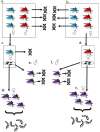This is a preprint.
Mechanisms of transcriptional regulation in Anopheles gambiae revealed by allele specific expression
- PMID: 38045426
- PMCID: PMC10690255
- DOI: 10.1101/2023.11.22.568226
Mechanisms of transcriptional regulation in Anopheles gambiae revealed by allele specific expression
Update in
-
Mechanisms of transcriptional regulation in Anopheles gambiae revealed by allele-specific expression.Proc Biol Sci. 2024 Sep;291(2031):20241142. doi: 10.1098/rspb.2024.1142. Epub 2024 Sep 18. Proc Biol Sci. 2024. PMID: 39288798 Free PMC article.
Abstract
Malaria control relies on insecticides targeting the mosquito vector, but this is increasingly compromised by insecticide resistance, which can be achieved by elevated expression of detoxifying enzymes that metabolize the insecticide. In diploid organisms, gene expression is regulated both in cis, by regulatory sequences on the same chromosome, and by trans acting factors, affecting both alleles equally. Differing levels of transcription can be caused by mutations in cis-regulatory modules (CRM), but few of these have been identified in mosquitoes. We crossed bendiocarb resistant and susceptible Anopheles gambiae strains to identify cis-regulated genes that might be responsible for the resistant phenotype using RNAseq, and cis-regulatory module sequences controlling gene expression in insecticide resistance relevant tissues were predicted using machine learning. We found 115 genes showing allele specific expression in hybrids of insecticide susceptible and resistant strains, suggesting cis regulation is an important mechanism of gene expression regulation in Anopheles gambiae. The genes showing allele specific expression included a higher proportion of Anopheles specific genes on average younger than genes those with balanced allelic expression.
Keywords: Allele; cis-regulation; insecticide; resistance; transcript.
Figures






References
-
- World Health Organisation, Malaria Report 2019. 1019.
-
- Ranson H. and Lissenden N., Insecticide Resistance in African Anopheles Mosquitoes: A Worsening Situation that Needs Urgent Action to Maintain Malaria Control. Trends Parasitol, 2016. 32(3): p. 187–196. - PubMed
-
- Holt R.A., et al., The genome sequence of the malaria mosquito Anopheles gambiae. Science, 2002. 298(5591): p. 129–49. - PubMed
Publication types
Grants and funding
LinkOut - more resources
Full Text Sources
Molecular Biology Databases
